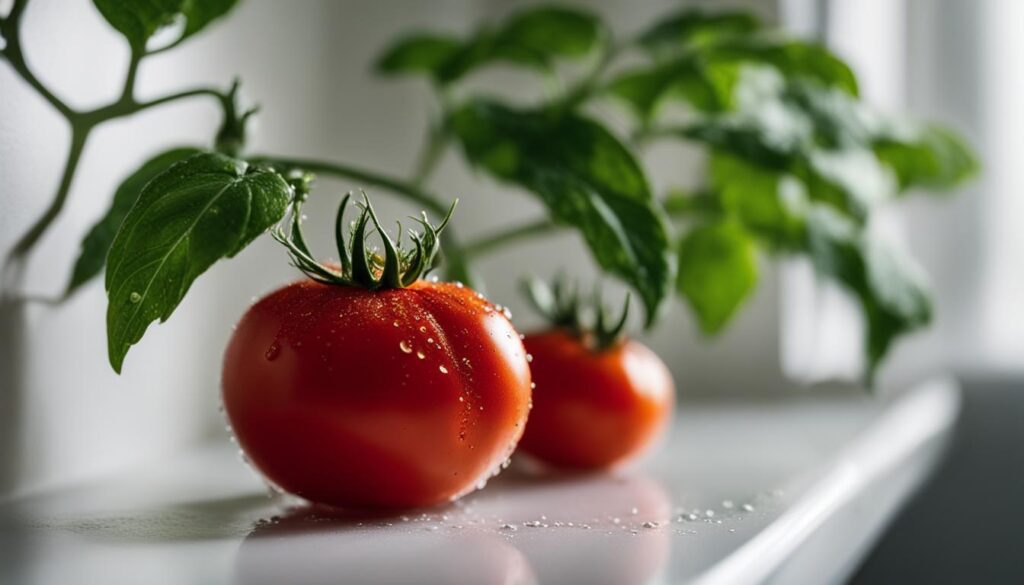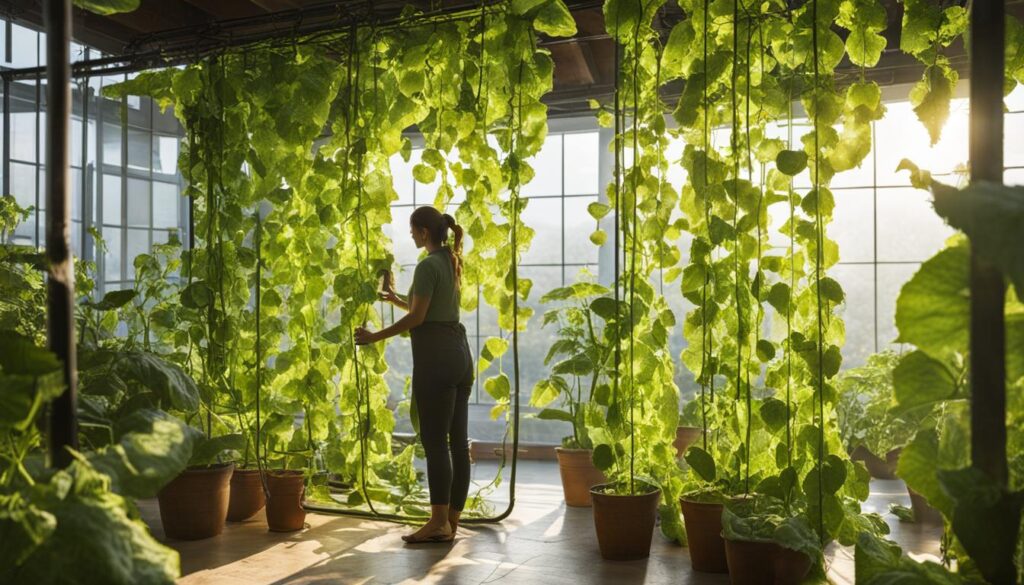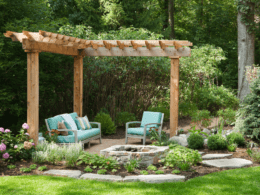Growing vegetables indoors during the winter months is a smart way to ensure a fresh and healthy supply of produce, even when the weather outside is cold and frosty. With the right choices, you can create a thriving indoor garden that will provide you with a bountiful harvest all year round. Whether you have limited space or simply want to enjoy the satisfaction of growing your own food, here are the best veggies to grow indoors in winter.
Key Takeaways:
- Indoor gardening allows you to grow fresh veggies all year round, even during the winter season.
- Tomatoes, squash, cucumbers, bell peppers, and herbs are ideal choices for indoor cultivation in winter.
- Provide proper light, temperature, and soil conditions for each plant to ensure successful growth.
- Choose the right pots or containers with proper drainage to support healthy plant development.
- Enjoy the benefits of a homegrown indoor garden by incorporating these veggies into your winter meals.
Tomatoes
When it comes to growing veggies indoors during winter, tomatoes are an excellent choice. With the right varieties and cultivation techniques, you can enjoy fresh, homegrown tomatoes even when it’s cold outside.
For indoor tomato cultivation, consider varieties like Toy Boy, Tiny Tim, Florida Petite, and Red Robin. These compact and prolific tomatoes are perfect for small spaces and containers.
To ensure successful growth, use unglazed pots with good drainage. Plant the seeds at a depth of around ¼ inch in garden soil and provide them with proper airflow. Tomatoes thrive in temperatures between 70 and 80°F, so make sure to maintain the ideal temperature range for optimal growth.
Tips for Indoor Tomato Cultivation:
- Choose compact varieties like Toy Boy, Tiny Tim, Florida Petite, and Red Robin.
- Use unglazed pots with good drainage.
- Plant seeds at a depth of around ¼ inch in garden soil.
- Ensure proper airflow for the plants.
- Maintain temperatures between 70 and 80°F for optimal growth.
Indoor Squash: Growing Squash Indoors in Winter
If you’re looking to grow veggies indoors during the winter, squash is a great option to consider. With the right care and conditions, you can enjoy fresh, homegrown squash all year round. Here’s what you need to know about growing squash indoors in winter.
Choose the Right Variety
When selecting squash for indoor cultivation, choose varieties that are well-suited for compact spaces. Crookneck squash and butternut squash are excellent choices. These plants thrive in pots and can be successfully grown indoors.
Provide Adequate Space
To give your squash plants enough room to grow, select a pot that is about 12 inches deep and 24 inches in diameter. This will allow the roots to spread out and provide sufficient space for the plant to develop. Plant three seeds in the middle of the pot, leaving a few inches of space between them.
Optimal Conditions for Growth
For successful indoor squash growth, it’s essential to provide the right conditions. Ensure regular watering to keep the soil moist but not waterlogged. Additionally, squash plants need ample sunlight, so place them in a sunny window or use artificial grow lights to supplement light levels. Maintain a consistent temperature between 68 and 85°F for optimal growth.
“Growing squash indoors allows you to enjoy the taste and freshness of homegrown produce, even during the winter months.”
By following these tips, you can enjoy a bountiful harvest of fresh squash throughout the winter. Indoor gardening provides a rewarding experience and the opportunity to savor the flavors of your own homegrown vegetables. Stay tuned for the next section to learn about growing cucumbers indoors in winter!
Indoor Cucumbers: A Fresh Addition to Your Winter Garden
When it comes to growing vegetables indoors during winter, cucumbers are a fantastic option. With their crisp texture and refreshing taste, indoor cucumbers can add a delightful twist to your salads and sandwiches, even when it’s cold outside. Let’s explore how you can successfully grow cucumbers indoors, bringing a touch of green to your winter garden.
Choosing the Right Seeds
Before starting your indoor cucumber project, it’s essential to select seeds that are specifically designed for indoor growth. Look for compact and dwarf varieties that thrive in containers. Some popular choices include ‘Bush Slicer,’ ‘Patio Snacker,’ and ‘Salad Bush.’ These compact cucumber plants not only fit well in indoor spaces but also produce an abundance of delicious cucumbers.
Creating a Suitable Growing Environment
To ensure the success of your indoor cucumber cultivation, provide your plants with a spacious environment. Choose pots that are at least 12 inches in diameter, allowing ample room for the plant’s roots to spread. Cucumbers are vines, so installing a trellis or a vertical support system will help them climb and save space.
Light is another crucial factor for indoor cucumber growth. Place your pots in a sunny location that receives at least six to eight hours of direct sunlight each day. If natural light is limited, consider using fluorescent grow lights to supplement the light requirements of your cucumber plants.
Caring for Your Cucumbers
Watering is an essential aspect of cucumber care. Keep the soil consistently moist, but avoid overwatering, as it can lead to root rot. Check the moisture level regularly and water your plants when the top inch of soil feels dry to the touch.
Indoor cucumber plants also benefit from regular feeding. Apply a balanced, water-soluble fertilizer every two weeks to provide them with the necessary nutrients for healthy growth and abundant cucumber production. Prune any yellow leaves, and regularly remove any male flowers that appear, as they do not produce fruit.
With the right seeds, an ideal growing environment, and proper care, you can enjoy an abundant harvest of fresh cucumbers, even during the winter months. So, why not add indoor cucumbers to your winter garden and savor the taste of homegrown goodness all year round?
Indoor Bell Peppers: A Winter Growing Guide
When it comes to growing vegetables indoors during the winter, bell peppers are a fantastic choice. Not only do they add vibrant colors to your indoor garden, but they also offer a delicious and nutritious addition to your meals. With the right techniques, you can successfully grow bell peppers indoors and enjoy fresh produce all year round.
To start your indoor bell pepper journey, it’s important to choose the right pots and soil. Opt for pots that are at least 12 inches deep to allow the roots to spread comfortably. A potting mix of vermiculite, peat moss, and coarse sand in equal proportions provides the ideal growing conditions for bell peppers.
When it comes to sowing the seeds, plant two or three bell pepper seeds in each pot. Place the pots in a room with a constant temperature between 65 and 75°F. This temperature range ensures that the bell peppers receive the warmth they need to thrive. Additionally, make sure the plants receive direct sunlight for at least six hours a day or use artificial grow lights to provide adequate light.
As your bell peppers grow, you can support their development by fertilizing them every two weeks with a balanced vegetable fertilizer. Remember to water the plants consistently, keeping the soil moist but not overly saturated. With proper care, you can harvest sweet and crunchy bell peppers from your indoor garden throughout the winter season.
Key Tips for Growing Bell Peppers Indoors:
- Choose pots that are at least 12 inches deep.
- Use a potting mix of vermiculite, peat moss, and coarse sand.
- Plant two or three bell pepper seeds in each pot.
- Maintain a constant temperature between 65 and 75°F.
- Provide direct sunlight for at least six hours a day or use artificial grow lights.
- Fertilize every two weeks with a balanced vegetable fertilizer.
- Keep the soil consistently moist but not soggy.
By following these tips, you’ll be well on your way to successfully growing bell peppers indoors this winter. Get ready to enjoy the fresh and flavorful taste of homegrown bell peppers, even when it’s cold outside!
Indoor Herbs: A Fresh Addition to Your Winter Garden
Growing herbs indoors during the winter months is a wonderful way to enhance your cooking and add a fresh touch to your dishes. Whether you have a spacious windowsill or a dedicated indoor garden, there are several herbs that thrive in indoor environments and can be easily grown. Here are some popular herbs that you can grow indoors during winter:
- Basil: A versatile herb that adds a delightful aroma and flavor to pasta, salads, and sauces. Basil requires direct sunlight or artificial light for at least six hours a day to ensure optimal growth.
- Parsley: A classic herb used for garnishing, parsley thrives in rich, well-drained soil. It requires direct sunlight or bright indirect light to grow well indoors.
- Thyme: Known for its earthy and aromatic flavor, thyme can be grown indoors with moderate sunlight or bright indirect light. It prefers well-drained soil and can tolerate dry conditions.
- Rosemary: An herb with a distinct pine-like fragrance, rosemary thrives in a sunny spot indoors. It requires well-drained soil and can tolerate slightly drier conditions.
When growing herbs indoors, it’s important to choose the right pot and soil. Use pots with good drainage and a suitable potting mix that provides adequate nutrition and moisture retention. Water your herbs regularly, allowing the soil to slightly dry out between waterings. Adding a layer of mulch can help retain moisture and prevent weed growth.
“Growing herbs indoors during winter not only adds freshness to your meals but also brings a touch of greenery and vitality to your living space. Plus, the convenience of having fresh herbs at your fingertips is unbeatable!”
Remember to trim your herbs regularly to promote bushier growth and prevent legginess. You can use the harvested herbs fresh or dry them for later use. Enjoy the delights of growing herbs indoors and elevate your culinary experiences, even during the winter months.
Conclusion
Growing vegetables indoors in winter is a fantastic way to enjoy a fresh supply of produce all year round. With the right choices and a little bit of care, you can successfully cultivate a variety of vegetables right in the comfort of your own home. Whether you have limited outdoor space, want to extend your gardening season, or simply enjoy the satisfaction of tending to your own indoor garden, indoor gardening is a rewarding and fulfilling activity.
By following the specific guidelines for each vegetable, such as providing adequate light, maintaining the right temperature, and ensuring proper soil conditions, you can create an optimal environment for your indoor plants to thrive. Tomatoes, squash, cucumbers, bell peppers, and herbs like basil, parsley, thyme, and rosemary are all excellent choices for indoor gardening in winter.
Not only does indoor gardening provide you with a fresh supply of nutritious vegetables throughout the colder months, but it also allows you to have more control over the quality and safety of your produce. You can avoid the use of harmful pesticides and enjoy the peace of mind that comes with knowing exactly what has gone into growing your food.
So why not give indoor gardening a try? With a little bit of time and effort, you can experience the joy of growing your own vegetables indoors, no matter the season. Start your winter gardening adventure today and discover the endless possibilities of indoor cultivation.
Can the Best Veggies to Grow Indoors in Winter Also Grow Without Sunlight?
Yes, certain vegetables like lettuce, spinach, and kale can thrive indoors in low light conditions during the winter months. These vegetables growing without sunlight only require a few hours of indirect light each day, making them perfect for indoor gardening. With the right care, they can still produce a bountiful harvest.
FAQ
Can I grow tomatoes indoors during winter?
Yes, tomatoes can be successfully grown indoors during winter. Choose varieties such as Toy Boy, Tiny Tim, Florida Petite, and Red Robin. Use unglazed pots with good drainage and provide proper airflow for successful cultivation.
How can I grow squash indoors?
Squash plants like Crookneck squash and butternut squash can be grown indoors in pots. Choose a 12-inch deep and 24-inch diameter unglazed pot. Plant three seeds in the middle of the pot, ensuring regular watering and sufficient light.
What do I need to grow cucumbers indoors?
For indoor cucumber growth, use seeds specifically designed for indoor cultivation. Choose large pots to accommodate the space needed by the cucumber plants. Create a climbing structure and ensure they receive plenty of direct sunlight and maintain appropriate temperatures.
Can I grow bell peppers indoors?
Yes, both red and green bell peppers can be successfully grown in pots indoors. Use a potting mix of vermiculite, peat moss, and coarse sand in equal proportions. Plant two or three bell pepper seeds in each pot and provide a constant temperature between 65 and 75°F.
Which herbs can I grow indoors during winter?
Herbs like basil, parsley, thyme, and rosemary can be easily grown indoors. Choose pots or containers that fit your window sill and provide proper drainage. Ensure adequate light and moisture for each herb.












